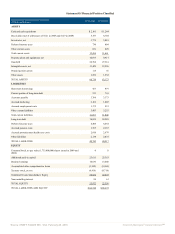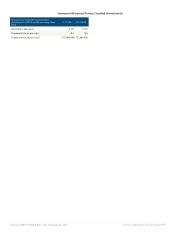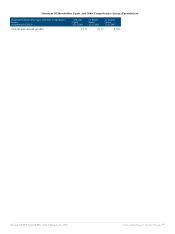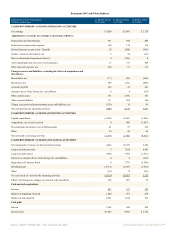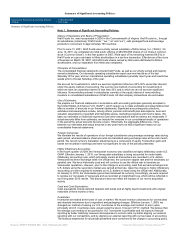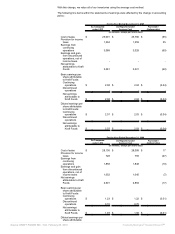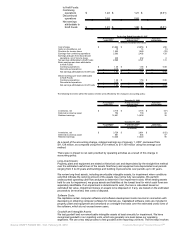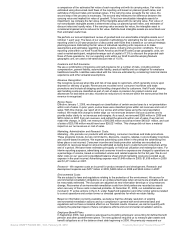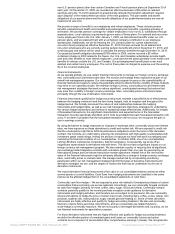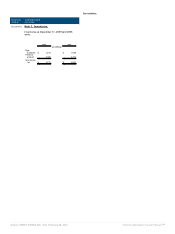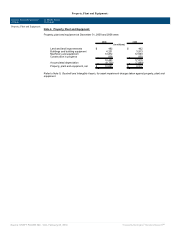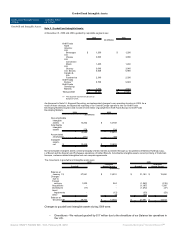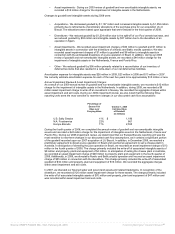Kraft 2009 Annual Report Download - page 198
Download and view the complete annual report
Please find page 198 of the 2009 Kraft annual report below. You can navigate through the pages in the report by either clicking on the pages listed below, or by using the keyword search tool below to find specific information within the annual report.
a comparison of the estimated fair value of each reporting unit with its carrying value. Fair value is
estimated using discounted cash flows of the reporting unit based on planned growth rates, and
estimates of discount rates and residual values. If the carrying value exceeds the fair value, the
second step of the process is necessary. The second step measures the difference between the
carrying value and implied fair value of goodwill. To test non-amortizable intangible assets for
impairment, we compare the fair value of the intangible asset with its carrying value. Fair value of
non-amortizable intangible assets is determined using our planned growth rates, and estimates of
discount rates and royalty rates. If the carrying value exceeds fair value, the intangible asset is
considered impaired and is reduced to fair value. Definite-lived intangible assets are amortized over
their estimated useful lives.
We perform our annual impairment review of goodwill and non-amortizable intangible assets as of
October 1 each year. The basis of our valuation methodology for estimating the fair value of our 20
reporting units is a 20-year projection of discounted cash flows that is based on our annual strategic
planning process. Estimating the fair value of individual reporting units requires us to make
assumptions and estimates regarding our future plans, industry and economic conditions. For our
reporting units within our Kraft Foods North America and Kraft Foods Europe geographic units, we
used a market-participant, weighted-average cost of capital of 7.5% to discount the projected cash
flows of those operations. For our reporting units within our Kraft Foods Developing Markets
geographic unit, we used a risk-rated discount rate of 10.5%.
Insurance and Self-Insurance:
We use a combination of insurance and self-insurance for a number of risks, including workers’
compensation, general liability, automobile liability, product liability and our obligation for employee
healthcare benefits. Liabilities associated with the risks are estimated by considering historical claims
experience and other actuarial assumptions.
Revenue Recognition:
We recognize revenues when title and risk of loss pass to customers, which generally occurs upon
shipment or delivery of goods. Revenues are recorded net of consumer incentives and trade
promotions and include all shipping and handling charges billed to customers. Kraft Foods’ shipping
and handling costs are classified as part of cost of sales. A provision for product returns and
allowances for bad debts are also recorded as reductions to revenues within the same period that the
revenue is recognized.
Excise Taxes:
Effective January 1, 2009, we changed our classification of certain excise taxes to a net presentation
within cost of sales. In prior years, excise taxes were classified gross within net revenues and cost of
sales. With this change, we report all of our excise and similar taxes using the net presentation
method. We made this change to better align our net revenues between various countries and to
provide better clarity to net revenues and margins. As a result, we removed $269 million in 2008 and
$276 million in 2007 from net revenues, and netted the amounts within cost of sales. If we had not
made this change, in 2009, net revenues of $40,386 million would have been $40,621 million, and cost
of sales of $25,786 million would have been $26,021 million. This change did not have a material
impact on our net revenues or cost of sales.
Marketing, Administration and Research Costs:
Marketing - We promote our products with advertising, consumer incentives and trade promotions.
These programs include, but are not limited to, discounts, coupons, rebates, in-store display incentives
and volume-based incentives. We expense advertising costs either in the period the advertising first
takes place or as incurred. Consumer incentive and trade promotion activities are recorded as a
reduction to revenues based on amounts estimated as being due to customers and consumers at the
end of a period. We base these estimates principally on historical utilization and redemption rates. For
interim reporting purposes, advertising and consumer incentive expenses are charged to operations as
a percentage of volume, based on estimated volume and related expense for the full year. We do not
defer costs on our year-end consolidated balance sheet and all marketing costs are recorded as an
expense in the year incurred. Advertising expense was $1,648 million in 2009, $1,639 million in 2008
and $1,471 million in 2007.
Research - We expense costs as incurred for product research and development. Research and
development expense was $477 million in 2009, $498 million in 2008 and $442 million in 2007.
Environmental Costs:
We are subject to laws and regulations relating to the protection of the environment. We accrue for
environmental remediation obligations on an undiscounted basis when amounts are probable and can
be reasonably estimated. The accruals are adjusted as new information develops or circumstances
change. Recoveries of environmental remediation costs from third parties are recorded as assets
when recovery of those costs is deemed probable. At December 31, 2009, our subsidiaries were
involved in 71 active actions in the U.S. under Superfund legislation (and other similar actions) related
to current operations and certain former or divested operations for which we retain liability.
Based on information currently available, we believe that the ultimate resolution of existing
environmental remediation actions and our compliance in general with environmental laws and
regulations will not have a material effect on our financial results. However, we cannot quantify with
certainty the potential impact of future compliance efforts and environmental remediation actions.
Employee Benefit Plans:
In September 2006, new guidance was issued surrounding employers’ accounting for defined benefit
pension and other postretirement plans. The new guidance required us to measure plan assets and
benefit obligations as of the balance sheet date beginning in 2008. We previously measured our
Source: KRAFT FOODS INC, 10-K, February 25, 2010 Powered by Morningstar® Document Research℠




